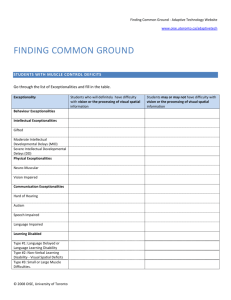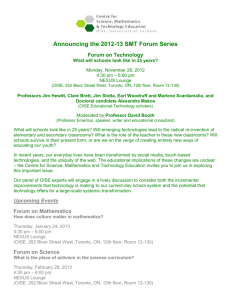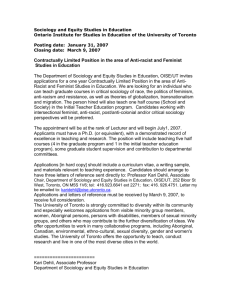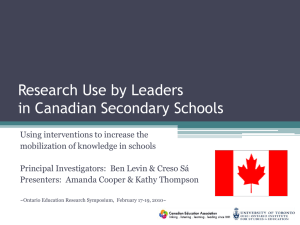Grade 4 Case Study - OISE
advertisement
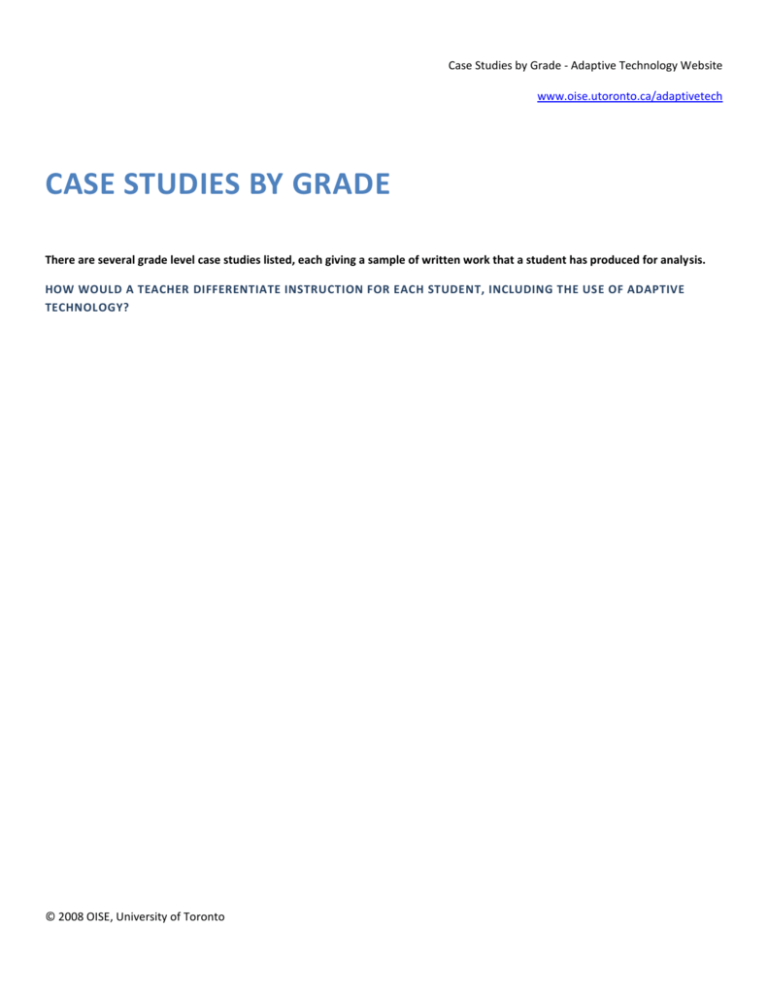
Case Studies by Grade - Adaptive Technology Website www.oise.utoronto.ca/adaptivetech CASE STUDIES BY GRADE There are several grade level case studies listed, each giving a sample of written work that a student has produced for analysis. HOW WOULD A TEACHER DIFFERENTIATE INSTRUCTION FOR EACH STUDENT, INCLUDING THE USE OF ADAPTIVE TECHNOLOGY? © 2008 OISE, University of Toronto Case Studies by Grade - Adaptive Technology Website www.oise.utoronto.ca/adaptivetech GRADE 2 CASE STUDY: END-OF-YEAR This student is at the end of his Grade 2 year. He is a bright student and his oral language is excellent. He takes part in class discussions and has an excellent general knowledge and excellent vocabulary. However, he has difficulty reading despite having had some Reading Recovery support, which was unsuccessful. The following is a sample of his written work. The top few lines of Heading, Characters, Setting and Problem were copied off board notes. What is below this is his written response done independently. Look at this sample and analyze what you think may be problematic. (Hint: look at the spacing). HOW CAN YOU DIFFERENTIATE INSTRUCTION FOR THIS STUDENT AND WHAT ADAPTIVE TECHNOLOGY COULD YOU USE? © 2008 OISE, University of Toronto Case Studies by Grade - Adaptive Technology Website www.oise.utoronto.ca/adaptivetech GRADE 3 CASE STUDY The sample of writing below is from a Grade 3 student who has been identified as having a Communication Exceptionality - Learning Disabled. FOR THOSE OF YOU WHO TEACH GRADE 3: IS THIS WRITING AGE-APPROPRIATE? LOOK AT BOTH THE CONTENT IN TERMS OF IDEAS AND THEN THE WRITING. CAN YOU IDENTIFY OR SUGGEST SOME OF THE DIFFICULTIES THIS STUDENT FACES AND WHAT YOU CAN DO TO ASSIST THIS STUDENT, BOTH BY DIRECT INSTRUCTION, DIFFERENTIATING INSTRUCTION AND/OR USING ADAPTIVE TECHNOLOGY? © 2008 OISE, University of Toronto Case Studies by Grade - Adaptive Technology Website www.oise.utoronto.ca/adaptivetech GRADE 4 CASE STUDY The sample of writing below is from a student who is 10 and-a-half years old. This is a sample of work that was shown at a School Team Meeting. LOOK AT THIS SAMPLE BOTH IN TERMS OF THE CONTENT, IDEAS AND THEN THE WRITING. CAN YOU IDENTIFY OR SUGGEST SOME OF THE DIFFICULTIES THIS STUDENT FACES AND WHAT YOU CAN DO TO ASSIST THIS STUDENT, BOTH BY DIRECT INSTRUCTION, OR RATHER, USING THE PRINCIPLES OF DIFFERENTIATING INSTRUCTION AS WELL AS USING ADAPTIVE TECHNOLOGY? © 2008 OISE, University of Toronto Case Studies by Grade - Adaptive Technology Website www.oise.utoronto.ca/adaptivetech GRADE 5 TO 6 CASE STUDY: END-OF-YEAR This is a letter that a student who had just completed grade 5 wrote from camp during the summer. It is a very typical sample of what she produces in class. She has a Communication Exceptionality - Learning Disabled. She has great social skills and gets on very well with others. She is very lively and orally expresses herself well. Just prior to this she had won the school’s Public Speaking contest. She is also motivated to write. LOOK AT THIS SAMPLE OF WRITTEN WORK AND LOOK AT IT FOR CONTENT, IDEAS AND WRITTEN LANGUAGE. HOW WOULD YOU DIFFERENTIATE INSTRUCTION FOR THIS STUDENT AND WHAT ADAPTIVE TECHNOLOGY COULD BE USED TO ASSIST HER TO IMPROVE HER WRITTEN LANGUAGE PRODUCTION IN CLASS? © 2008 OISE, University of Toronto Case Studies by Grade - Adaptive Technology Website www.oise.utoronto.ca/adaptivetech GRADE 9 CASE STUDY: APPLIED ENGLISH This sample of work is from a student who has been identified as having an Intellectual Exceptionality - MID and has been placed in an Applied Grade 9 English Class. This is a journal entry. READ THROUGH THIS ENTRY AND THEN MAKE SUGGESTIONS AS TO HOW YOU COULD DIFFERENTIATE INSTRUCTION. DECIDE WHAT ADAPTIVE TECHNOLOGY WOULD HELP THIS STUDENT IMPROVE HER WRITTEN LANGUAGE PRODUCTION. © 2008 OISE, University of Toronto Case Studies by Grade - Adaptive Technology Website www.oise.utoronto.ca/adaptivetech GRADE 9 CASE STUDY: TEST RESULTS The sample of work below is part of the test termed the TOWL-2 by Donald D. Hammill and Stephen C. Larsen (1990. Test of Written Language , 2nd edition. Austin: PRO-ED, Inc.). In this test, students are given a picture and asked to write a story about the picture. The writing produced is then analyzed and scored for levels of ideas (ideation), quality of language used, grammar, spelling, etc. The following is the response from a student in Grade 9. READ THE RESPONSE AND ANALYZE IT FOR LEVEL OF IDEAS AND LANGUAGE. CAN YOU IDENTIFY SOME OF THE AREAS THAT ARE PROBLEMATIC? CAN YOU SUGGEST WAYS TO DIFFERENTIATE INSTRUCTION AND USE ADAPTIVE TECHNOLOGY TO ASSIST THIS STUDENT IMPROVE HIS WRITTEN LANGUAGE? © 2008 OISE, University of Toronto Case Studies by Grade - Adaptive Technology Website www.oise.utoronto.ca/adaptivetech GRADE 10 CASE STUDY: TEST RESULTS The sample of work below is part of the test termed the TOWL-2 by Donald D. Hammill and Stephen C. Larsen (1990. Test of Written Language , 2nd edition. Austin: PRO-ED, Inc.). In this test, students are given a picture and asked to write a story about the picture. The writing produced is then analyzed and scored for levels of ideas (ideation), quality of language used, grammar, spelling, etc. The following is the response from a student in Grade 10. READ THE RESPONSE AND ANALYZE IT FOR LEVEL OF IDEAS AND LANGUAGE. CAN YOU IDENTIFY SOME OF THE AREAS THAT ARE PROBLEMATIC? CAN YOU SUGGEST WAYS TO DIFFERENTIATE INSTRUCTION AND USE ADAPTIVE TECHNOLOGY TO ASSIST THIS STUDENT IMPROVE HIS WRITTEN LANGUAGE? © 2008 OISE, University of Toronto Case Studies by Grade - Adaptive Technology Website www.oise.utoronto.ca/adaptivetech GRADE 10.1 CASE STUDY: TEST RESULTS The sample of work below is part of the test termed the TOWL-2 by Donald D. Hammill and Stephen C. Larsen (1990. Test of Written Language , 2nd edition. Austin: PRO-ED, Inc.). In this test, students are given a picture and asked to write a story about the picture. The writing produced is then analyzed and scored for levels of ideas (ideation), quality of language used, grammar, spelling, etc. The following is the response from a student in Grade 10. READ THE RESPONSE AND ANALYZE IT FOR LEVEL OF IDEAS AND LANGUAGE. CAN YOU IDENTIFY SOME OF THE AREAS THAT ARE PROBLEMATIC? CAN YOU SUGGEST WAYS TO DIFFERENTIATE INSTRUCTION AND USE ADAPTIVE TECHNOLOGY TO ASSIST THIS STUDENT IMPROVE HIS WRITTEN LANGUAGE? © 2008 OISE, University of Toronto Case Studies by Grade - Adaptive Technology Website www.oise.utoronto.ca/adaptivetech GRADE 10.2 CASE STUDY: TEST RESULTS The sample of work below is part of the test termed the TOWL-2 by Donald D. Hammill and Stephen C. Larsen (1990. Test of Written Language , 2nd edition. Austin: PRO-ED, Inc.). In this test, students are given a picture and asked to write a story about the picture. The writing produced is then analyzed and scored for levels of ideas (ideation), quality of language used, grammar, spelling, etc. The following is the response from a student in Grade 10. READ THE RESPONSE AND ANALYZE IT FOR LEVEL OF IDEAS AND LANGUAGE. CAN YOU IDENTIFY SOME OF THE AREAS THAT ARE PROBLEMATIC? CAN YOU SUGGEST WAYS TO DIFFERENTIATE INSTRUCTION AND USE ADAPTIVE TECHNOLOGY TO ASSIST THIS STUDENT IMPROVE HIS WRITTEN LANGUAGE? © 2008 OISE, University of Toronto Case Studies by Grade - Adaptive Technology Website www.oise.utoronto.ca/adaptivetech GRADE 11 CASE STUDY This sample of writing is from a student on entry into Grade 11. He is extremely bright, having an IQ score in the gifted range. He has been identified as having a Communication Exceptionality - (Gifted) Learning Disability, as he has superior scores in visual spatial abilities but significant weaker abilities in oral language production. He enjoys writing, and often writes long stories/narratives both from what he has read, seen or his own ideas. LOOK AT THIS SAMPLE BELOW AND ATTEMPT TO READ IT. WHAT IS YOUR OVERALL IMPRESSION? HOW CAN YOU DIFFERENTIATE INSTRUCTION AND USE ADAPTIVE TECHNOLOGY TO ASSIST THE STUDENT TO IMPROVE THE QUALITY OF HIS WRITTEN LANGUAGE PRODUCTION? © 2008 OISE, University of Toronto
